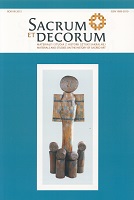Wątki narodowe i mesjanistyczne w ikonografii św. Jana z Dukli na przykładzie cyklu hagiograficznego Tadeusza Sulimy Popiela w Dukli
National and messianic themes in the iconography of St John of Dukla. A case study of the hagiographic cycle by Tadeusz Sulima Popiel in Dukla.
Author(s): Cyprian Janusz MorycContributor(s): Grażyna Ryba (Editor)
Subject(s): History, Fine Arts / Performing Arts, Theology and Religion
Published by: Wydawnictwo Uniwersytetu Rzeszowskiego
Keywords: St John of Dukla; Messianism; Sarmatism; iconography; Tadeusz Popiel; Czesław Bogdalski; militarism; sacralization of history
Summary/Abstract: As a representative of Sarmatian culture, St John of Dukla was depicted in hagiographic and liturgical literature, as well as in iconography, as an ancient hero resplendent with the glow of Christian virtues. This medieval saint, whose popularity has never waned, was perceived as an incarnation of the lofty ideals of piety, mercy, and fervent service to the nation and the Church. To illustrate his spirituality, hagiographers relied on the language and imagery of the Old Testament, referring to the humble Franciscan as “a true Moses and leader of the people”, “the hope of city gates”, or “certain salvation”. The national and Messianic elements that linked the life of St John and the history of his earthly homeland to the history of the Chosen People already figured centrally in the early iconography of the saint, with its most emblematic image of the Defensor Leopolis, but became even more widespread in the 19th and 20th centuries. An analysis in terms of Messianism allows one to rediscover the underappreciated painted life of St John on the walls of the church in Dukla, which in a sense summarizes and recapitulates the motifs of traditional iconography. Created in 1903, this outstanding masterpiece by Tadeusz Popiel highlights the patriotic and Messianic elements that sacralize the past of the nation. The ideological program of the Dukla cycle was influenced by Father Czesław Bogdalski, an enthusiast of the Bernardine order and worshipper of national saints, who authored a popular book on the life and worship of St John. It is his book that seems to have furnished the basis for the iconography of individual paintings. Święty Jan z Dukli jako reprezentant kultury sarmackiej postrzegany był w utworach hagiograficznych, liturgicznych i ikonografii według modelu antycznego bohatera jaśniejącego blaskiem cnót chrześcijańskich. Średniowieczny święty, który nigdy nie stracił na popularności, ucieleśniał wysokie ideały pobożności, miłosierdzia i gorliwości w służbie Kościoła i narodu. Hagiografowie dla nakreślenia Jego duchowej sylwetki sięgali po obrazy i terminy starotestamentalne i nazywali skromnego franciszkanina „prawdziwym Mojżeszem i wodzem ludu”, „nadzieją bram miasta” czy „niezawodnym ocaleniem”. Rys mesjanistyczny i narodowy, łączący biografię skromnego franciszkanina i dzieje jego ziemskiej ojczyzny z historią Narodu Wybranego, wyraźnie naznaczył dzieła dawnej ikonografii Duklanina, z najbardziej emblematycznym wizerunkiem Defensor Leopolis, jednak z jeszcze większym nasileniem objawił się w realizacjach z wieku XIX i XX. Analiza ikonografii świętego w aspekcie mesjanizmu pozwala odkryć na nowo Jego niedoceniany malarski żywot na ścianach kościoła w Dukli, będący swoistym podsumowaniem i streszczeniem tradycyjnej ikonografii. To wybitne dzieło Tadeusza Popiela z roku 1903 eksponuje pierwiastki patriotyczne i mesjanistyczne, sakralizujące przeszłość narodu. Na program ideowy dukielskiego cyklu decydujący wpływ wywarł o. Czesław Bogdalski, pasjonat przeszłości zakonu i czciciel narodowych świętych, a zarazem autor popularnego opracowania o życiu i czci pośmiertnej błogosławionego współbrata. Jak się wydaje, publikacja ta legła u podstaw ikonografii poszczególnych przedstawień.
Journal: Sacrum et Decorum. Materiały i studia z historii sztuki sakralnej
- Issue Year: 2015
- Issue No: 8
- Page Range: 8-34
- Page Count: 27
- Language: English, Polish

